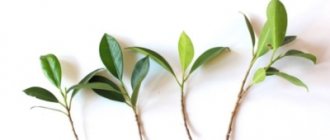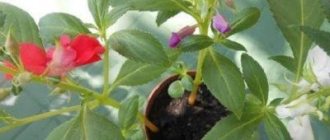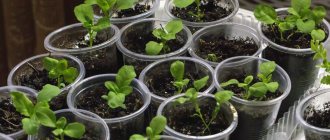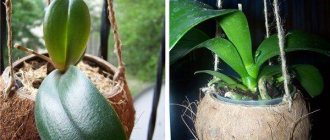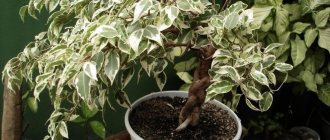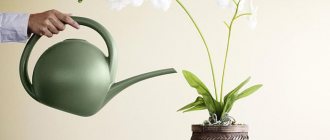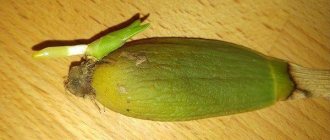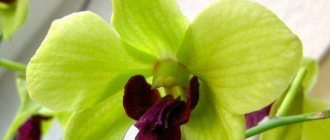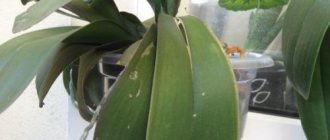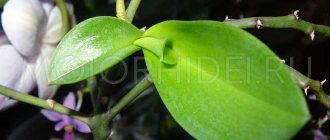Orchids are epiphytes that naturally grow on trees that serve as their support. Such plants breathe and feed through their roots. Therefore, for a flower, the air permeability of both the soil and the pot in which they are grown is of great importance.
In our country, orchids are considered capricious plants, but in their homeland they are planted everywhere: on thatched roofs, in ceramic pipes, in empty wooden baskets, and simply nailed or tied to mossy fences. The main condition is that they have enough air, moisture, nutrition, and the sun does not burn them.
Our climate leaves its mark on the cultivation of this exotic flower. Providing him with a whole tree to live in an apartment is an impossible task, but it can be replaced with bark, which forms the basis of the substrate for orchids. It also includes other components.
Difference in Definitions
In order not to make a mistake in choosing the right filling for a flower pot, you should first understand the difference between soil, substrate and soil :
- Soil is a more universal name, as it denotes both a natural mineral component of the earth and one manually created for gardening purposes. The composition is rich in organic components.
- Soil is a natural component of the earth that contains deposits of plant and animal organisms. Natural environment for the growth of most representatives of the plant world.
- Substrate is an artificially created mixture for growing vegetation in it; it does not necessarily contain soil. From Latin it is translated as sublayer, litter. The main function is to feed the plant with nutrients and oxygen.
The concepts are often confused, and a flower shop may sell you a substrate mixed with earth.
Ordinary soil is absolutely not suitable for growing orchids; they simply do not need soil.
Block
For lithophytic species, that is, representatives of orchids that do not need a substrate or soil at all, planting on a block is provided. The following materials are suitable for creating a block:
- Wood.
- Pine bark.
- Grape vine.
A landing block is formed in the following order:
- First of all, the workpiece is given the desired shape.
- A hole is made in the middle of the workpiece with a flexible wire for attaching the orchid.
- Markings are made according to which the flower will be installed.
Then the plant is placed on the block so that the leaves hang down. A small amount of moss is placed under the root, and part of the roots are also covered with it.
The substrate is used for adult plants and meets all requirements. When preparing your own soil, a good guide is the ingredients of the soil in which the orchid was sold.
Peculiarities
Soil for orchids should not contain soil. Typically a mixture consists of several components , each of which serves its purpose.
Also, ingredients not only of natural origin, but also artificial ones, began to be added to the substrate for growing a flower. This is done to improve the quality of filling and living conditions of the plant.
The main requirement for the substrate is to prevent rotting of the root system by ensuring free access to oxygen. Some types of orchids are quite light-loving, so the universal substrate should not interfere with the free entry of light rays.
Main characteristics of an “ideal” substrate
Let us recall that most orchids are epiphytes, that is, “air” plants. In the wild, they live on the surface of trees, bushes, and stumps.
Therefore, the soil mixture for orchids should:
- ensure air circulation around the roots so that they can “breathe”;
- allow light to penetrate to the roots for their participation in photosynthesis;
- fix the plant to ensure a stable position of the roots inside the pot;
- quickly absorb moisture, but also dry quickly (this allows you to recreate the conditions of tropical forests, where long-term drought is replaced by heavy rains);
- provide good drainage;
- absorb nutrients and release them slowly;
- have a pH level of 5.5-6.5 (slightly acidic environment).
The importance of making the right choice
Important criteria for a properly selected substrate for orchids: quality and composition . Compliance with the requirements ensures harmonious development, growth and systematic flowering.
Today, every flower shop offers a ready-made mixture developed specifically for this type of plant. But not every finished product can be absolutely beneficial for your flower, so be careful when choosing it.
Nuances to pay attention to:
- The bark pieces are solid, strong, without visible damage. Size – up to 3 cm each. It is important that they do not crumble in your hands.
- The pieces of charcoal should not be larger than 2 cm and should not crumble.
- Moss should not be wet. A quality component – well dried and disinfected.
- If the substrate looks like a hard earthen lump, such a product is considered to be of poor quality.
- There should be no soil in the substrate, as it will accumulate moisture, harden and deprive the mixture of its ability to transmit oxygen.
- The substrate should be free of dust and moldy pieces.
Why is store-bought substrate bad?
As the popularity of orchids grows, so does the choice of substrates for planting these flowers. There are mixtures of Russian and foreign manufacturers. The main components of the standard substrate are sphagnum moss and tree bark. But there are also more expensive components.
Unfortunately, the increase in ready-made substrate options has led to the quality of the soil mixture beginning to deteriorate. Increasingly, growers are replacing bark and moss with soil dust and peat , which can be harmful to the plant. That is why it is recommended to prepare the soil yourself.
Photo
Next in the photo you can see the soil mixture for the plant:
What should be the required soil composition?
In order for the orchid to live on your windowsill as long as possible, it is important to choose the correct filling for the flowerpot. For epiphytic orchids (in the wild growing on the bark of trees), the following compositions are recommended :
- 90% pine bark, 5% charcoal, 5% dried and disinfected moss.
- 70% bark, 10% peat, 10% perlite, 10% redwood bark.
- 50% bark, 20% foam pieces, 15% expanded clay, 10% peat, 5% coal.
For terrestrial varieties of orchids, such mixtures are suitable:
- 40% peat, 20% dry oak leaves, 20% pine bark, 20% expanded clay.
- 35% peat, 35% clay sand, 15% perlite, %% pine bark.
What is better not to add to the composition?
Expanded clay is quite often used in preparing a good composition for growing orchids. This product has certain advantages - it retains moisture well.
Among the negative nuances, this component is characterized by the property of accumulating salts contained in water for irrigation. In the future, this is fraught with salinization of the entire soil, which will lead to a loss of the ability to retain vital moisture.
When expanded clay dries, it begins to draw moisture from the roots of the plant . Therefore, if this ingredient is still present in the composition, you should carefully monitor the sufficient amount of watering, and also periodically change the mixture. It is strictly forbidden to add soil to the substrate for orchids.
Such a rash step will lead to withering of the plant and drying out of the root system. If the flower shop sold a mixture with soil, it is better to sift it.
Growing
In the moss
In flower shops, you can often find mini-phalaenopsis, sold in pots with moss. This method of planting is possible, although it requires certain skills in caring for orchids:
- How is moss used to grow orchids? Use live or dried sphagnum moss or peat moss. It is placed in pots in its pure form, without adding anything. In this form, the plant is suitable for transportation and maintenance in an apartment or greenhouse;
Sphagnum moss is used in its pure form. - Advantages and disadvantages of moss substrate. Moss is a natural and environmentally friendly material. Among its advantages :
- Easily accessible and widespread;
- Moisture capacity;
- Purity.
Cheapness;
The disadvantages follow from the advantages:
- Acidic environment;
- Moisture holding capacity can provoke moisture stagnation and rotting;
- Over time it collapses.
- Water the plant from above;
In a nutrient medium
Orchid seeds germinate in symbiosis with mushrooms, so for artificial germination the following is used :
- Nutrient medium;
- Or a nutritional substance.
The nutrient medium at home is a gel-like mass , the basis of which is water and agar-agar. Culture medium recipe (g/l):
- Calcium nitrate (calcium nitrate) – 1 g;
- Ammonium sulfate – 500 mg;
- Potassium phosphate – 250 mg;
- Magnesium sulfate – 250 mg;
- Ferrous sulfate – 25 mg;
- Manganese sulfate – 7.5 mg;
- Agar-agar – 15 g;
- Glucose (sucrose) – 20 g;
- Distilled water – 1 l.
Attention! The acidity of the environment is 5.1-5.5 pH. To regulate and equalize the acidity of the solution, use potassium carbonate or orthophosphate acid.
In polystyrene foam
Polystyrene foam is an excellent replacement for epiphytic substrate if the latter is not available. Polystyrene foam is a synthetic porous building or packaging material , it:
- Inert;
- Doesn't rot;
- Has little weight;
- And its granules are perfect for loosening the soil.
Large pieces are used as a substrate or drainage, small granules are used as a leavening agent. Often large sheets of foam are used as blocks for young orchids or seedlings.
Polystyrene foam is used instead of epiphytic substrate.
The advantages of growing orchids in an inert substrate such as polystyrene foam are:
- Low probability of root rotting;
- Sterility;
- And good aeration.
The disadvantage of polystyrene foam is:
- Almost zero moisture capacity;
- The need for more frequent feeding;
- And also the low decorative value of the material.
However , this is easy to hide behind a colored flowerpot.
What is each component used for?
Each component for the substrate is important and has specific functions:
- Moss . Widely used for preparing the composition. It is hygroscopic and absorbs moisture vapor well. Contains many useful microelements - more than in tree bark. Disinfected moss prevents the development of pathogenic bacteria.
- Bark. The most popular component for preparing a good substrate. In percentage terms, it predominates in the composition.
It has all the necessary characteristics - it evenly distributes the moisture received during the irrigation process and allows air to pass through perfectly.To protect the orchid from insects and resin, it is better to heat-treat the bark before use. This recommendation applies to cases where the substrate is prepared independently.
- Drainage . Used to provide air access, drainage of excess liquid, as well as stable fixation of the root system. The most commonly used are expanded clay, pieces of polystyrene foam, small crushed stone, and gravel. This layer is placed at the bottom of the pot.
- Earth .
For most varieties of orchids, this component is superfluous. Small amounts can be added to the composition for growing terrestrial plant species. In the case of homemade preparation, it is recommended to calcine the earth at high temperatures in the oven for 20 minutes. Thanks to this manipulation, pathogenic bacteria will not be able to harm your flower. - Coal .
Charcoal is added to almost every substrate, but in a proportion of no more than 5% of the total mass. Improves air and water permeability. Keeps the soil from becoming waterlogged and prevents it from oxidizing. It also acts as an antiseptic and prevents putrefactive processes from developing. - Minerals. They are considered a nutritional supplement and compensate for the lack of useful elements. They prevent salt from accumulating and maintain the required level of acidity.
Most often, the orchid is fed with the following minerals:- potassium;
phosphorus;
- nitrogen;
- boron;
- iron;
- magnesium;
- sulfur.
In minimal quantities:
- manganese;
- zinc;
- chlorine;
- silicium.
How to prepare ingredients, basic rules
In order to save money and time, experienced orchid owners stock up on the necessary ingredients for the substrate for future use .
wood ash in large sizes, and then chop it into pieces of 3-4 cm. Store preferably in plastic bags, without access to air. Powdered ash is used as an antiseptic for dusting fresh plant cuts.- sphagnum moss component is a fairly moisture-intensive material. Therefore, after collecting it, it needs to be washed and dried in partial shade. Dry moss is packaged in bags and stored in a dark place.
- pine bark it is taken only in dry form, without visible traces of the bark beetle, but you still need to know how best to prepare it. You need to choose pieces 1-2 cm thick; thicker bark is more difficult to cut. To disinfect, the brought natural material should be heated in a slightly open oven for no more than 5 minutes.
Pine bark, which is less resinous and has a longer decomposition period than pine bark, is becoming popular among gardeners.
- The underground part of the fern is dug out of the ground in spring or late autumn so that the plant is without leaves. The roots are cut into small pieces and stored in an airtight container.
All components collected from the forest must be subjected to heat treatment. Pine cones and charcoal boil with boiling water, thereby increasing the degree of water absorption.
What is suitable to replace natural materials?
In addition to organic components, the composition for orchids may also contain inorganic ones:
- vermiculite (mica-based mineral) – absorbs moisture and has a draining effect;
- expanded clay – retains moisture, provides stability to the root system;
- perlite (also included in cat litter) – perfectly absorbs excess moisture.
There are gardeners who use crushed bricks as drainage. This is not recommended, as over time it turns into dust and interferes with the normal circulation of air and water.
What to choose: ready-made substrate or homemade one?
It is difficult to compare store-bought soil and homemade soil. The finished product contains the ingredients in the correct proportions, is processed and is ready to eat.
But you can’t always be sure of its quality. You will be 100% confident in the composition you prepare yourself , but it is not always possible to obtain every component.
The best recommendation would be to add your own components to a product purchased in a store, which will significantly improve and enrich it.
Pros of home soil:
- cheapness;
- high quality;
- individual selection of components suitable specifically for your type of orchid;
- exact observance of proportions.
Minuses:
- sometimes components are difficult to obtain;
- Preparation and disinfection of pine bark is a labor-intensive process.
Cooking rules at home
What kind of soil should an orchid have? The most important thing is the preparation of the components . Necessary:
- Assemble yourself;
- Or buy it in a store;
- And prepare everything you need;
- And also allocate enough time and space for preparation.
The best period for harvesting bark, fallen leaves, etc. is autumn . It is preferable to remove bark from fallen trees. If you use material from a coniferous tree, make sure that there is as little resin and mold on the bark as possible.
You can collect sphagnum directly along with fallen leaves. Coal can be obtained by burning a birch log in a fire (the absence of debris in the fire is important), and sand can be obtained on the banks of the river. When all the components are ready, they are mixed in the required proportions .
The prepared substrate must be sterilized. Before use, it is moistened with water from a sprayer.
Advice! It is best to prepare the substrate immediately before use. Add old cornmeal to a freshly prepared sterile substrate (if it is not infected with parasites) to introduce beneficial microflora.
How should you choose a substrate in the store?
When choosing purchased soil, follow these rules::
- pieces of bark - whole, dense, without defects, up to 3 cm each;
- the pieces do not crumble in your hands under mechanical stress;
- charcoal is strong, up to 2 cm each;
- dry moss;
- absence of dust and mold;
- Before purchasing, it is important to read the label on the package, which indicates the proportional composition, as well as information that it is suitable specifically for your type of orchid.
Is it possible to make it yourself?
Beginning flower growers purchase ready-made substrate for orchids in garden stores. Their more experienced colleagues, on the contrary, believe that you will get high-quality soil if you prepare it with your own hands. In addition, such a substrate has a number of advantages:
- minimum cost;
- guaranteed quality of components;
- individual selection of ingredients according to varieties;
- simple recipes;
- drawing up the required proportions.
According to the rules for caring for orchids, replanting and complete replacement of the soil should be done every 2-3 years.
What are the ready-made products for growing flowers?
Popular brands of soil used by gardeners:
- Orchiata (composed of New Zealand pine bark);
- ZeoFlora (soil contains minerals with zeolite);
- Compo Sana (the substrate has high moisture resistance and air permeability);
- EffectBio (produces a wide range of mixtures and soil enrichers);
- Fusco (all substrates contain only natural ingredients);
- Seramis (contains clay granules).
When choosing, you should remember that the soil has a different composition depending on the variety and age of the plant.
An overview of different ready-made substrates for orchids can be found in this video:
The best commercial soils for orchids
Don't want to bother with mixing ingredients? There is an alternative: buy a ready-made substrate in the store.
The following soils received the greatest number of positive reviews:
- Orchiata. A sustainable growing medium consisting of granulated bark from the New Zealand radiata pine Pinus radiate. Special processing of the bark (artificial aging) makes it possible to obtain a material with a modified top layer that retains water and nutrients. At the same time, the internal part remains solid and is preserved without destruction for several years. Suitable for growing Phalaenopsis, Cymbidium, Dendrobium, Cattleya, Vanda, Odontoglossum and Oncidium.
- “Orchid Pro” from Aurica Gardens. Traditional soil for growing epiphytes. The composition includes selected components: pine bark, sphagnum, coconut fiber, charcoal and coconut shavings.
- Seramis for orchids. Contains patented Seramis clay granules and pine (pine) bark of different fractions. Suitable for cultivating and growing all types of orchids.
- Ceoflora (ZeoFlora). Universal mineral soil for keeping orchids both in closed systems and in pots with a drainage base. Contains natural zeolite. The environmentally friendly product has a granular form, retains moisture, and provides sufficient air to the roots. Can be used as a stand-alone medium or additive in multi-component substrates.
- Lechuza Pon and Lechuza Orchidpon are granular mineral substrates. Structurally stable: does not decompose and does not cake. Does not lose its properties, so it can be reused. Lechuza soils consist of granules of pumice, volcanic lava, and zeolite. In addition to these components, Lechuza Orchidpon contains humic granules, and Lechuza Pon contains long-lasting fertilizers.
The use of Lechuza soils gives the greatest effect in combination with special flowerpots (with automatic watering) of the same brand.
To summarize, it should be noted that for optimal growth and development of an orchid, a light, drained, breathable soil with low acidity is required. You can collect such soil yourself, replant the orchid in a one-component substrate, or choose a ready-made store-bought version with a large number of additives, fertilizers and nutrients.
How to make the mixture yourself?
For home cooking you will need:
- pine or other coniferous tree bark (5 parts);
- sphagnum moss (3 parts);
- coarse sand (1 part);
- peat or fern roots (1 part).
Even if you don’t have some of the components on hand, you can make a simple mixture that is suitable for growing orchids in greenhouses :
- 5 parts bark;
- 1 part crushed charcoal.
This video explains how to make a substrate for orchids:
How to replace the natural composition?
As you can see, most of the components of the substrate for orchids are substances of organic origin . However, if it is impossible to obtain or buy them, the materials can be replaced with inorganic ones.
- Pine bark is replaced with coarse river sand, small pieces of polystyrene foam or leaf soil.
- Instead of sphagnum moss, hydrogel, polystyrene, and foam rubber are used.
- Crushed activated carbon can be used as a sorbent rather than wood ash.
- Perlite, vermiculite, brick chips, crushed stone, gravel, pebbles, expanded clay - these are all interchangeable drainage materials. If one is not available, another is used.
Is it possible to plant a houseplant in ordinary soil?
For normal functioning, the orchid root system requires constant access to light and oxygen. Accordingly, the substrate must contain light components, but the earth will simply kill the roots under its pressure.
The dense composition of the soil will disrupt the drainage process , and the water will stagnate. An orchid simply cannot grow and develop in such unnatural conditions. The usual habitat for an exotic flower is the surface of a tree, and not dense soil.
Recovery
If the orchid begins to fade, the leaves turn yellow, the plant sheds its inflorescences, then add fertilizer, use biofungicides for fungus or insecticides for insects. If all resuscitation efforts do not help, then the flower is planted on perlite. The material is clean. The orchid is given the opportunity to recover.
We recommend: How to use perlite for flowers?
The flower is removed from the ground or substrate. The roots are washed in a solution of potassium permanganate or hydrogen peroxide and freed from soil. It is recommended to treat it with Fitosporin. Place the bush on clean perlite. The old soil is discarded. If expanded clay or other substrate was used, it can be washed, kept in an antiseptic, and reused.
- The mineral pellets are saturated with filtered, warm water. The optimal temperature is 37 0C. Allow the substrate to soak for 24 hours. Excess liquid goes into the pots.
- Make a hole and place a bush in it. The orchid's heel and aerial roots remain on top of the soil.
- Place the flower in perlite, in a warm room where the temperature is maintained at 250C and humidity up to 70%.
- Organize additional lighting using a phytolamp. Lighting should be diffused. It is not recommended to change the place for the orchid. It takes her a long time to get used to the new microclimate.
- There is no need to cover the bush with a dome or film. Covering material is used if it is impossible to create high humidity in the room. The plant is ventilated daily.
Water the plant when the substrate takes up liquid from the pots. You can use wick irrigation technology. In this case, the pots are filled with a nutrient solution. A string and wick are lowered from the mineral filler to the solution. You can make 3-4 sections to better saturate the perlite.
In the future, the orchid can be transplanted onto the ground, bark or other substrate. It is necessary to wait until it produces new root shoots and leaves.
Possible errors and solutions to problems
Incorrectly selected or prepared soil will harm the roots of your plant. Due to the dense substrate, the orchid may rot. A dying flower can be revived by transplanting it into a new substrate.
Choosing the wrong soil for a flower often poses many problems.:
- Sometimes a white coating appears on the orchid substrate, which resembles fluffy yarn. This is a mold caused by wood rotting processes. This happens when the substrate sticks too tightly to the root system.
- Shaggy mold on the orchid substrate can eventually spread to the flower itself, covering not only its roots, but also its stem.
The ideal environment for fungus is a high level of humidity. If the crop is watered too often and the substrate does not have time to dry out, this problem arises. - If the roots and substrate of the orchid are covered with a silvery coating, then there is nothing wrong with that. This is the normal state of a healthy flower when the soil in its pots has dried out. It is enough to ensure normal watering, and the problem will disappear over time.
For a luxurious, healthy plant and constant flowering of the orchid, you should approach the issue of choosing soil consciously. Without the right substrate, serious problems can arise, including the death of the flower. Care when purchasing or making soil will bring wonderful fruits of floriculture.
What qualities should a substrate for orchids have?
photo from floralelle.com
In order for orchids to develop well and regularly delight with their wonderful blooms, they need to create the proper conditions: nutrition, watering, humidity and lighting. Both the composition and quality of the substrate play one of the most important roles in this.
The plant has a number of requirements for the soil. Firstly, it must be breathable, because only with good aeration will the root system of the flower develop normally. It, along with leaves, participates in photosynthesis. Stagnant air can provoke the proliferation of pathogenic microorganisms.
Orchid is a moisture-loving plant. However, excess moisture can lead to various fungal diseases. Therefore, the substrate must not only be moisture-absorbing, but also water-permeable so that the liquid in the pot does not stagnate.
And, of course, the flower needs nutrition, which it receives from the air and plant bark. At the initial stage, the substrate must have the necessary supply of nutrients, the amount of which can subsequently be regulated by feeding.
